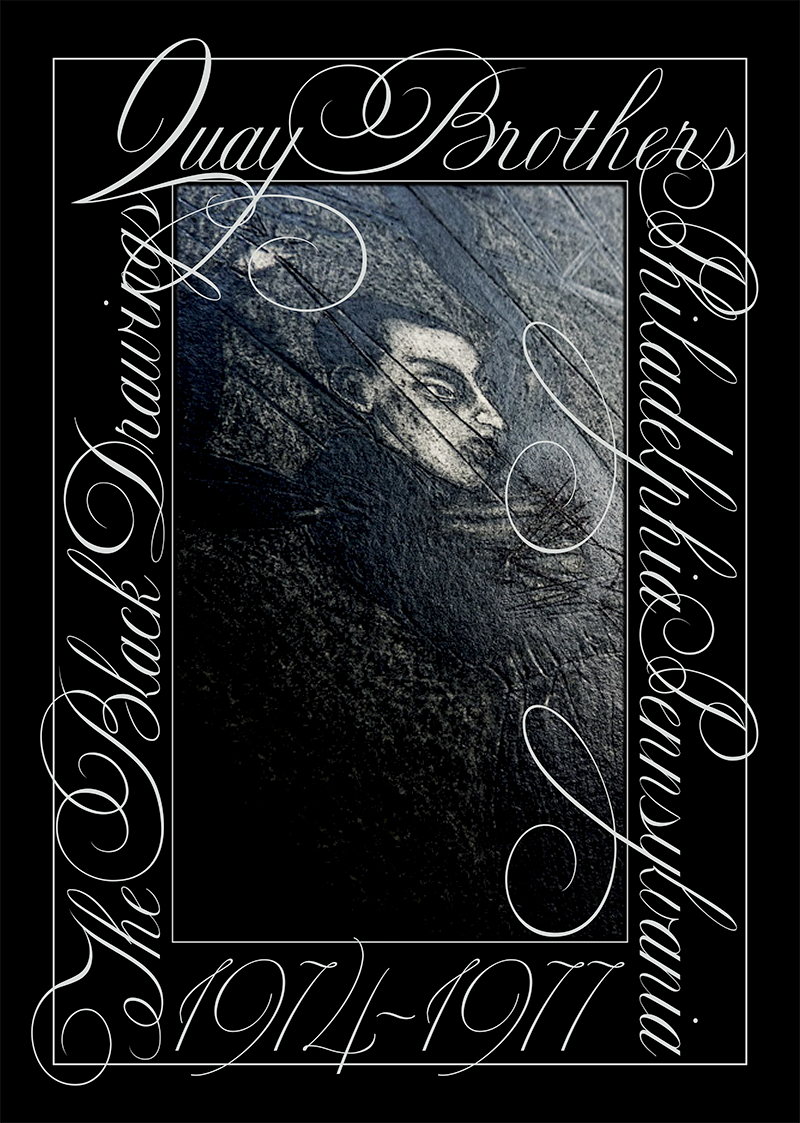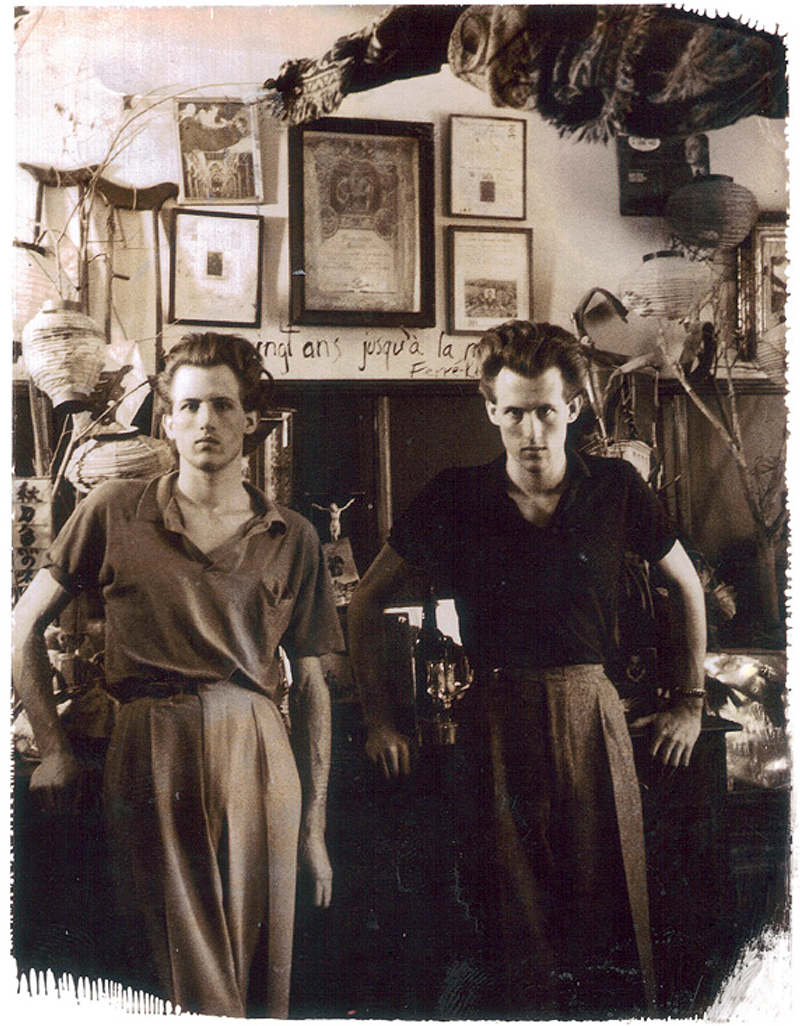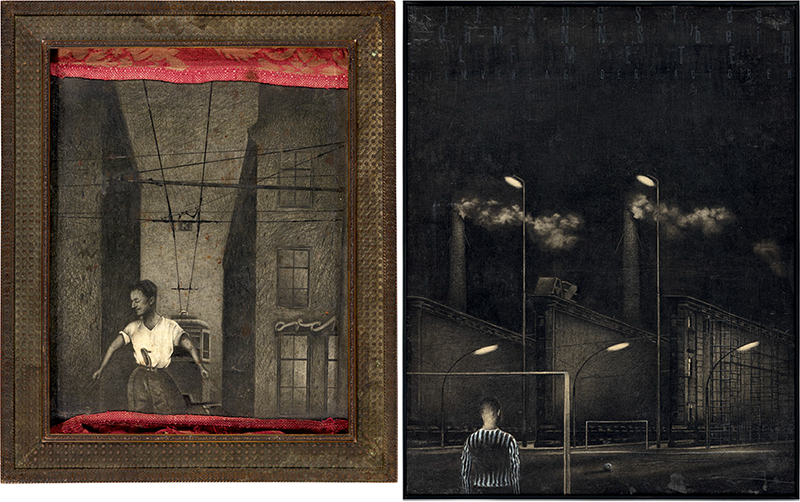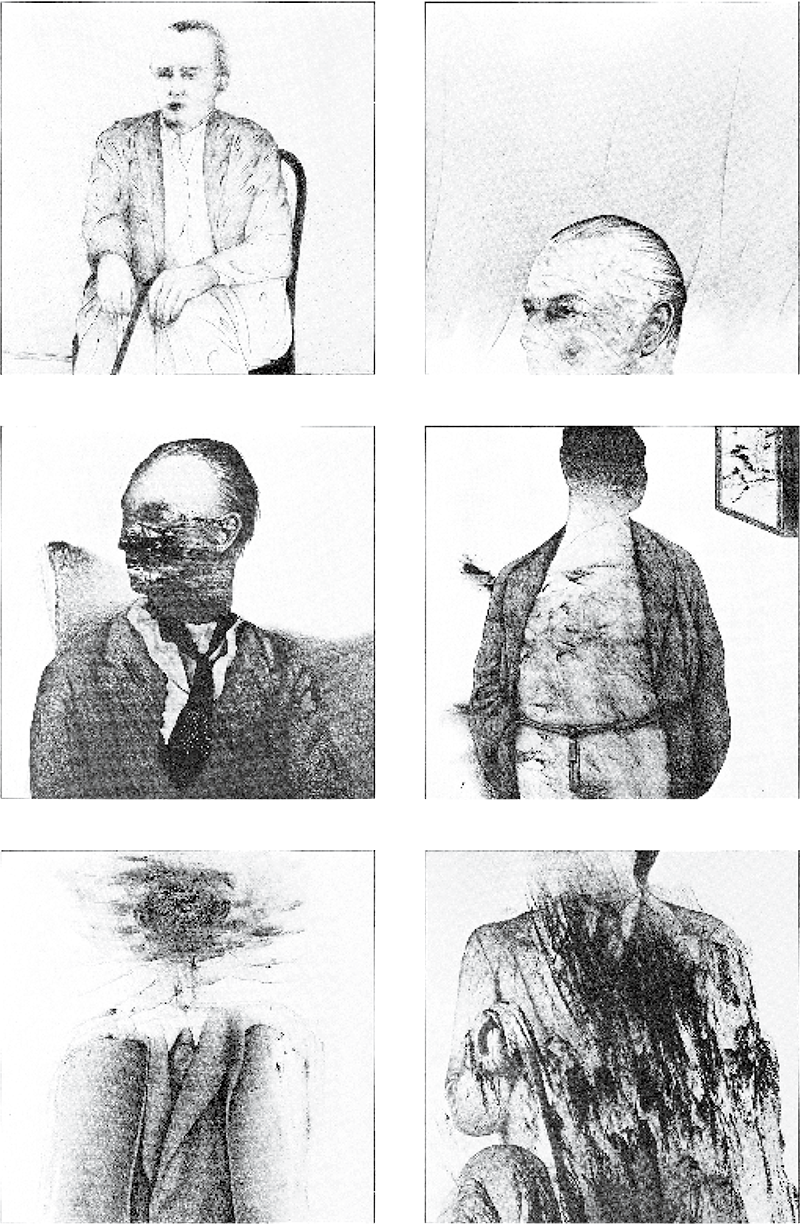
Editor's Note: The just realeased book, The Quay Brothers, The Black Drawings, Philadelphia Pennsylvania, 1974–1977, edited by Tommy Simoens and published by Ludion Publishers, explores the filmmakers training as graphic artists and the artwork that they created. The following excerpt and images are reproduced with permission of the publisher.

Quays inside 718 South 6th Street, Philadelphia, 1974–77, Polaroid, 12.7 × 10.2 cm (5 × 4 in)
The first observer to incite the twins to do something with their graphic skills was a high-school teacher, Anthony Paladino. He introduced them to Rudolph Freund (1915–69), a wildlife artist who, with a particular talent for details and tactile suggestion, illustrated books and magazines for Time Life and a wide variety of nature guides. After some hesitation between a vocation as gymnastics teachers or as graphic artists, in 1965 the Quay Brothers entered the Philadelphia College of Art (PCA), graduating in 1969. During these years they were already carrying out experiments with a borrowed film camera. First attempts such as In the Mist, Pohadka, Golgotha, and Venable Llewellyn’s Last Walze (all c. 1967–69) demonstrate that they were already exploring quite specific filmic ideas and techniques. In the Mist is basically a random series of sketches filmed in live action, whereas Pohadka and Golgotha consist entirely of cutout animation. One particularly striking scene of In the Mist shows some repeated shots of solitary trees, mysteriously collapsing all of a sudden in the middle of a field. In Venable Llewellyn’s Last Walze this situation is reversed, and here it is a lonely soldier who falls to the ground, surrounded by trees.

LEFT: Ceux Qui Désirent Sans Fin, c. 1974–77. RIGHT: The Goal Keeper’s Anxiety At The Penalty Kick, c. 1974–77
When they consecutively applied for a further three years of study at the Royal College of Art (RCA) in London (1969–72), the brothers initially aimed for the film department. As the restricted number of places in that department were already taken, they settled for graphic arts. However, every now and then they could gain use of a Bolex camera via some fellow students, and were thus able to create in guerrilla fashion, over weekends or during a college holiday, a string of three films. Der Loop Der Loop continues the cutout style of Pohadka, though with a lot more detail and refinement. What all three short films from the RCA period have in common is their use of existing music (Xenakis, Bruckner, Wagner), with the quote from Dvorak’s Symphony No. 8 as a precedent in the earlier Venable Llewellyn’s Last Walze. The films all show a propensity toward choreography rather than real dramatic action, and each title is fueled by an unmotivated tension between two protagonists, most literally a musical duel in Il Duetto, most allusively a lonely soldier under attack from an invisible enemy in Venable Llewellyn’s Last Walze. For the animated collages, the Quay Brothers mainly used photographic reproductions and photocopies. The visual style of the films is consequently more rudimentary than their quite refined graphic output of the same period, which involved delicate pencil drawings, etchings, and engravings among several other techniques. Palais en Flammes is the most elaborate and diverse film of the four, using cutout animation with live-action shots interspersed throughout. The animation is often limited to particular details in the image, and there are several visual references to early Buñuel, including as the opening image a citation from the final shot of L’Age d’or (1930) with the scalp on the cross.

LEFT: The Lover Practicing Hate, c. 1974–77, RIGHT: Kiev vs Wales, detail, c. 1987
On their return to the United States, money had to be earned to pay o student debts. Trying to work their way into the industry by doing illustration, the brothers went scouting for work in New York along 5th Avenue, knocking on the doors of publishing houses such as Doubleday and Columbia Records as well as Playboy magazine. They managed to bring in a variety of assignments, demonstrating great versatility by alternating between book covers, magazine illustrations, and record sleeves. To their early portfolio they could add a cover for a Mozart record, a cover for a book on Stockhausen, and a series of drawings for music reviews in the New York Times, as well as a cover for the novel A Scanner Darkly (1977) by Philip K. Dick. One of the most stimulating opportunities was the first American publication of Anthony Burgess’s novel The Clockwork Testament; or, Enderby’s End (1974), which involved not just the front and back covers but another eleven entirely autonomous drawings inside.

Book illustrations for The Clockwork Testament; or, Enderby's End by Anthony Burgess, published by Alfred Knopf, New York, 1975
Yet, overall, work proved very haphazard and o en unsatisfactory as they had no artistic control. Recurring situations such as lettering or colors being added to their graphic designs without prior notification made them realize that 5th Avenue was a dead-end street. Demoralized, they capitulated and largely turned their backs on the New York creative industry. Exiling themselves to Philadelphia, the brothers decided to make a living from daytime jobs that ranged from very basic typography work to washing dishes and lifeguarding at a swimming pool. Their nights they devoted to their true vocation: a graphic form of cinema. No longer having access to the printmaking facilities they had enjoyed as art students, it was during this self-inflicted “Philadelphian Gulag” period that the Quay Brothers started to cultivate an a ordable format that would fit their now-muted desires. For the time being, they would have to settle for a graphic, instead of a truly cinematographic, practice.
For the full story and the full wealth of images: The Quay Brothers, The Black Drawings.

LEFT: The Lover Practicing Hate, c. 1974–77, RIGHT: Kiev vs Wales, detail, c. 1987
On their return to the United States, money had to be earned to pay o student debts. Trying to work their way into the industry by doing illustration, the brothers went scouting for work in New York along 5th Avenue, knocking on the doors of publishing houses such as Doubleday and Columbia Records as well as Playboy magazine. They managed to bring in a variety of assignments, demonstrating great versatility by alternating between book covers, magazine illustrations, and record sleeves. To their early portfolio they could add a cover for a Mozart record, a cover for a book on Stockhausen, and a series of drawings for music reviews in the New York Times, as well as a cover for the novel A Scanner Darkly (1977) by Philip K. Dick. One of the most stimulating opportunities was the first American publication of Anthony Burgess’s novel The Clockwork Testament; or, Enderby’s End (1974), which involved not just the front and back covers but another eleven entirely autonomous drawings inside.

Book illustrations for The Clockwork Testament; or, Enderby's End by Anthony Burgess, published by Alfred Knopf, New York, 1975
Yet, overall, work proved very haphazard and o en unsatisfactory as they had no artistic control. Recurring situations such as lettering or colors being added to their graphic designs without prior notification made them realize that 5th Avenue was a dead-end street. Demoralized, they capitulated and largely turned their backs on the New York creative industry. Exiling themselves to Philadelphia, the brothers decided to make a living from daytime jobs that ranged from very basic typography work to washing dishes and lifeguarding at a swimming pool. Their nights they devoted to their true vocation: a graphic form of cinema. No longer having access to the printmaking facilities they had enjoyed as art students, it was during this self-inflicted “Philadelphian Gulag” period that the Quay Brothers started to cultivate an a ordable format that would fit their now-muted desires. For the time being, they would have to settle for a graphic, instead of a truly cinematographic, practice.
For the full story and the full wealth of images: The Quay Brothers, The Black Drawings.
